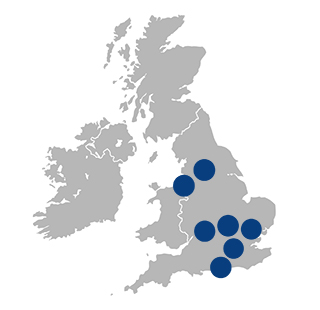
Written by:

Medically Reviewed by:
Last Updated:
February 17th, 2025
Tramadol Rehab
What is tramadol rehab?
Tramadol rehab is a structured programme that supports you in overcoming dependence on tramadol. In a safe and caring environment, tramadol rehab combines medical detox with a variety of therapies and aftercare. This approach is designed to address both the physical and psychological effects of tramadol addiction, helping you regain control and build a healthier future without dependency.
With professional support, you’ll learn coping strategies that ease withdrawal symptoms and provide a strong foundation for long-term recovery.
In what setting can tramadol rehab be taken?
Tramadol rehab can take place in both outpatient and inpatient settings, depending on your individual needs and addiction severity. Outpatient rehab offers flexibility, allowing you to continue your daily activities while attending scheduled treatment sessions.
However, outpatient rehab may not be suitable for severe tramadol addictions, as withdrawal stages can be intense and difficult to manage alone.
For individuals with a more significant dependency, inpatient rehab at Liberty House is often recommended. In an inpatient setting, you’re provided with 24/7 support, a structured schedule and a safe space free from daily triggers, making it easier to stay committed and manage withdrawal symptoms under medical guidance.
Is tramadol rehab necessary for me?
Deciding if tramadol rehab is right for you can be confusing, especially if you began using it as a prescribed medication. Tramadol may have initially been helpful for pain, but addiction can develop over time, often without realising it.
To assess if tramadol rehab might be necessary, ask yourself the following questions. If you answer ‘yes’ to any of them, it might indicate a need for further support:
- Do you find yourself taking larger amounts of tramadol than you intended or using it for longer than planned?
- Have you tried to reduce or stop using tramadol but found it difficult?
- Do you spend significant time obtaining, using or recovering from the effects of tramadol?
- Do you experience strong cravings or urges to use tramadol, even when you know it could be harmful?
- Has your tramadol use started to interfere with your responsibilities, relationships or personal goals?
If any of these questions resonate with you, tramadol rehab could provide the support you need to reclaim control over your life and well-being.
How is a tramadol rehab programme structured?
Understanding what to expect can help ease any concerns if you’re considering tramadol rehab. Rehab is often deeply personal, and people may not share their experiences openly, which can make the idea of rehab feel uncertain.
Here, we’ll outline each stage of the programme at Liberty House to give you a clearer picture of what lies ahead.
Initial assessment
Your journey starts with an initial assessment, where compassionate professionals take the time to understand your unique relationship with tramadol. In a relaxed environment, they’ll ask about your health history, personal background and goals. This assessment shapes a treatment plan tailored specifically to your needs, helping you feel confident and supported as you begin your recovery.
Detox
During detox, tramadol is gradually eliminated from your body under close medical observation. This stage can be challenging, as withdrawal symptoms may arise, such as muscle aches, insomnia and cravings. However, at Liberty House, you’ll receive both physical and emotional support to manage these symptoms safely. Medical professionals provide medications to ease discomfort, while psychological support helps you handle the emotional aspects of withdrawal.
Therapy
Therapy forms the core of the rehab process, addressing the underlying reasons for tramadol dependence. Through Cognitive Behavioural Therapy (CBT), group counselling and holistic approaches like yoga and meditation, you’ll develop new coping strategies for stress and cravings. These therapies equip you with tools to manage triggers and maintain balance in your life, making it easier to stay tramadol-free.
Aftercare
Aftercare provides a bridge between rehab and everyday life. This phase includes continued therapy sessions, support groups and regular check-ins to ensure you remain supported as you adjust to a new routine. The aftercare programme is vital for reinforcing your progress and giving you access to a network of support and strategies to maintain sobriety.
Why shouldn’t I detox from tramadol at home?
Detoxing from tramadol at home may seem like an attractive option, especially as it’s free and feels familiar. However, while it might seem convenient, home detox presents serious risks due to the severity of tramadol withdrawal symptoms. The physical and psychological challenges of detoxing alone increase the risk of relapse and health complications.
Here, we’ll look at each stage of withdrawal and explain the benefits of professional support compared to attempting detox at home.
Days 1-3: Initial withdrawal
- Symptoms: Anxiety, agitation, muscle aches, sweating and insomnia are common as the body adjusts to life without tramadol.
- What can go wrong at home: Without support, these symptoms can quickly become overwhelming, leading to an increased urge to use tramadol to relieve discomfort.
- How Liberty House can help: Medical staff are on hand to provide medications for symptoms like anxiety and insomnia, offering a controlled environment that reduces the risk of relapse.
Days 4-7: Peak withdrawal
- Symptoms: During this stage, withdrawal symptoms peak. You may experience nausea, vomiting, diarrhoea, elevated blood pressure and cravings.
- What can go wrong at home: The risk of dehydration from vomiting and diarrhoea is high without medical intervention, which can lead to health complications. Additionally, cravings can feel insurmountable, increasing the risk of relapse.
- How Liberty House can help: Liberty House provides fluids and medications to manage nausea and regulate blood pressure. Round-the-clock medical support ensures that any complications are promptly addressed, offering a safe and comforting environment.
Days 8-14: Stabilisation
- Symptoms: Physical symptoms usually begin to subside but psychological challenges like mild anxiety, depression and cravings may continue.
- What can go wrong at home: Without professional guidance, lingering symptoms can make it difficult to stay on track, especially without someone to help you manage cravings.
- How Liberty House can help: During this phase, you’ll benefit from psychological counselling and structured routines that help stabilise mood and build resilience. The ongoing support prepares you for life beyond detox, ensuring you have the mental strength to maintain progress.
Take the next step with Liberty House
If tramadol addiction is affecting your life, know that Liberty House is here to support you on the path to recovery. Our caring team will be with you every step of the way, providing the guidance and understanding you need to build a life free from tramadol dependency. Reaching out is the first step toward a healthier future.






